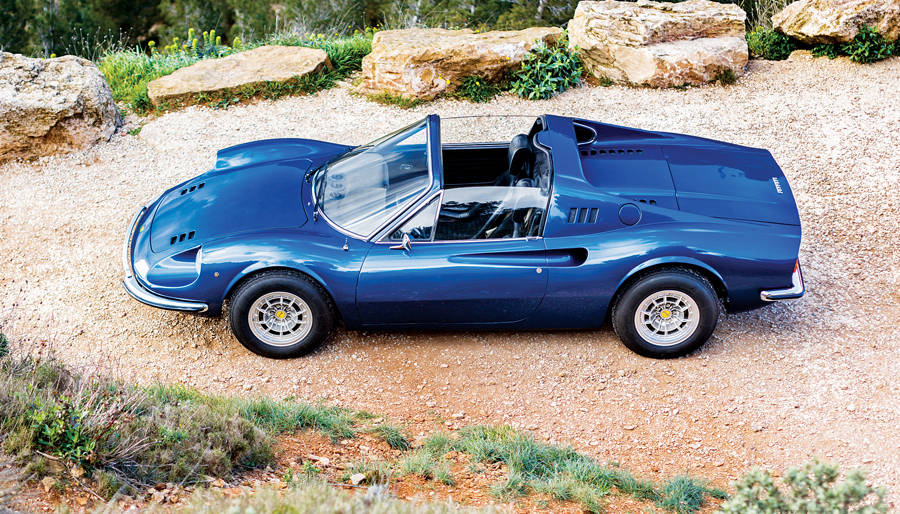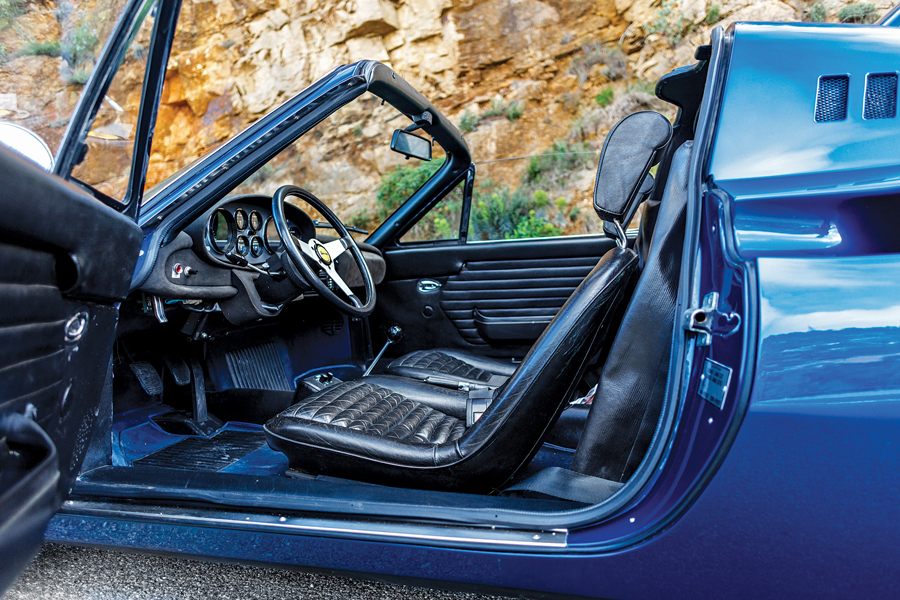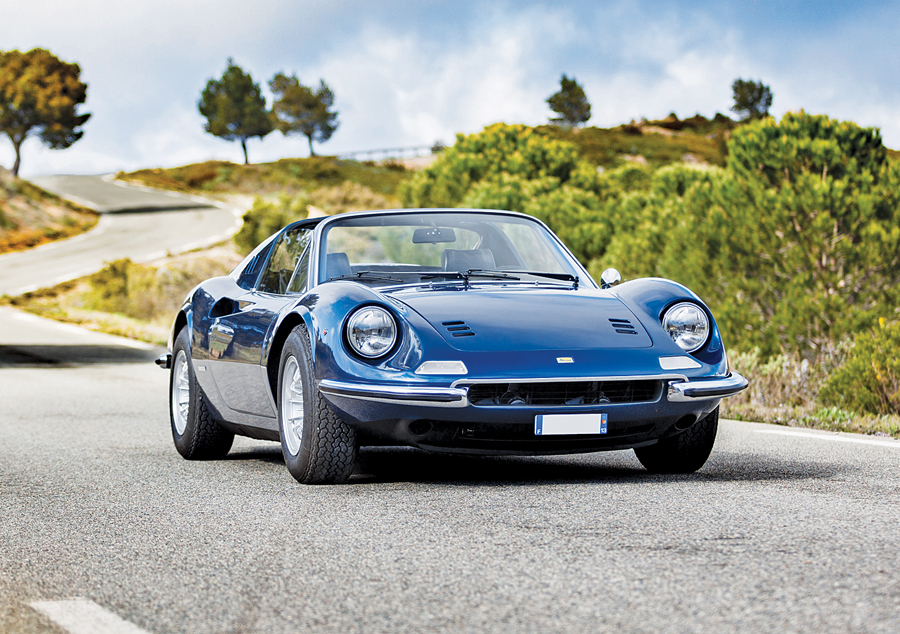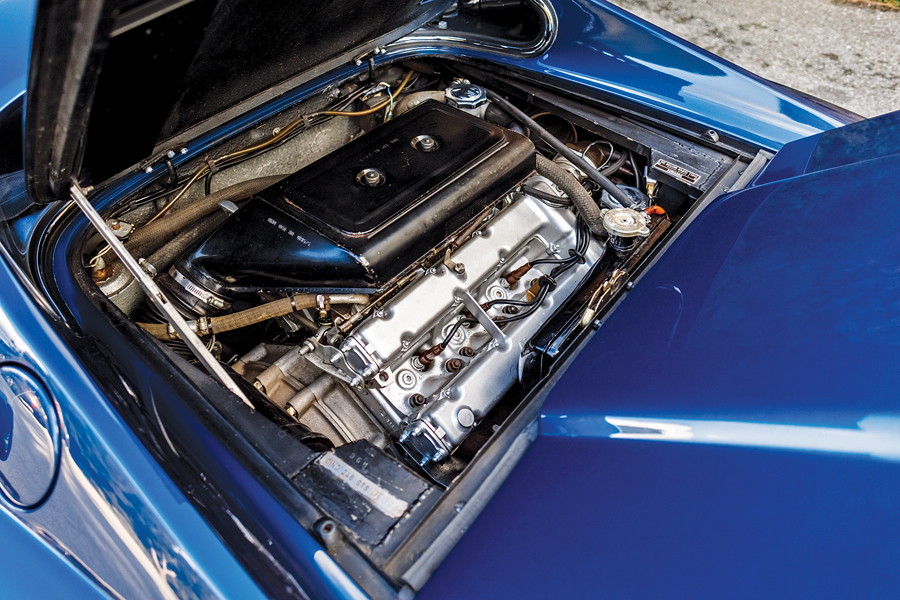SCM Analysis
Detailing
| Vehicle: | 1974 Ferrari 246 GTS Dino Spyder |
| Years Produced: | 1972–74 |
| Number Produced: | 1,274 |
| Original List Price: | $15,225 (1974) |
| SCM Valuation: | $363,000 |
| Tune Up Cost: | $3,500 |
| Distributor Caps: | $350 |
| Chassis Number Location: | Stamped in the frame above the left rear shock absorber |
| Engine Number Location: | Side of block before oil filter |
| Club Info: | Ferrari Club of America |
| Website: | http://www.FerrariClubofAmerica.org |
| Alternatives: | 1974 Porsche 911, 1974 Jaguar E-type, 1974 DeTomaso Pantera, 1974 Maserati Bora |
| Investment Grade: | B |
This car, Lot 174, sold for $636,977, including buyer’s premium, at RM Sotheby’s Monaco Auction on May 12, 2018.
Enzo Ferrari’s life was a story of triumph and tragedy. There were many high points and many low points. He lived with a wife and a son — yet retreated during the evening to a mistress and their son.
His work consumed him, and the fruits of his labor could be extreme success or extreme failure. Death was never far away — with an early loss of his parents, the tragic loss of a son, and the loss of drivers racing his cars.
Mr. Ferrari’s memoir, Le Mie Gioie Terribili, which translates to My Terrible Joys, chronicles these memories.
There is a cold reality to many of the losses. The drivers died while doing what they loved, but the loss of his son was a different matter.
A beloved son
Enzo’s son, Alfredo Ferrari, was named after Enzo’s father and brother. Like his father’s brother, the younger Alfredo was nicknamed Dino. At the time Dino was born, Enzo was running Scuderia Ferrari, a private racing team that was founded “for participating in car racing in Italy and abroad with Alfa Romeo cars.” The Scuderia, or squad, sold shares to wealthy members who could drive cars prepared by the Scuderia or watch professionals recruited to drive their cars.
Enzo Ferrari was a talented and accomplished driver by the time Dino was born, but having observed families destroyed by racing injuries and death, Enzo decided to retire from driving and spend time with his son.
Enzo actually split his time between his son and his business interests, which included management and ownership interest in Scuderia Ferrari and consulting for Pirelli, Alfa Romeo and an Italian oil company. Additionally, Enzo had distribution rights for Alfa Romeo in the regions of Romagna and Emilia.
Dino was not a healthy child. By the time he was 7, he was being treated for a yet-undiagnosed illness. As a teen, he had difficulty walking and began losing motor control. Eventually he was diagnosed with muscular dystrophy, a disease that is still deadly today.
Dino would go into work with his father, wander the plant, talk with the workers and sit in the cars. He would talk racing with his father. He attended technical school in Modena and studied engineering at a Swiss university.
It was while studying engineering that Dino started work on a 1.5-liter automobile engine.
A special V6 engine
Dino’s health continued to decline. As the story goes, Enzo and engineer Vittorio Jano would visit Dino in the hospital and ponder which engine design to use for a new Formula 2 series.
Enzo credited Dino for suggesting a V6 engine.
The hospital summit is a great story, and no fault can be assigned to a father creating a legacy for a son, but the reality is a bit different. Jano was a talented engine designer and he needed no help from Dino to build a great engine.
The three-way conversation and Dino’s contribution to the V6’s origin may be a myth, but the resulting V6 engine was very real.
The Jano-designed V6 Formula 2 engine was named the Dino engine in honor of Dino Ferrari. While it was the first of the series, it would not be the last. No less than 52 variations of Dino engines and Dino cars would follow Jano’s first design.
Dino engines would power Ferrari Formula cars. Dino engines would power Ferrari sports racers; Dino engines would power Ferrari-built street cars. Dino engines would even find their way into Fiats and the Lancia Stratos Rally car.
Ferrari ranks up with Coca Cola and McDonald’s as one of the most well-known brands in the world. This did not happen by luck.
Enzo Ferrari was aware of the importance of his brand, and the decision to introduce the Dino name was not taken lightly.
Dino engines could be found in race cars wearing Ferrari badges or Dino badges. Ferrari was less concerned with the badging than the results. V6-powered Ferraris won constructor’s championships, driver’s championships and sports-car races around the world.
There was never a question of whether the car was a Dino or Ferrari — it was always a Ferrari victory.
V6 Dino engines were not exclusive to Ferrari. Ferrari outsourced the production of 206 and 246 engines to Fiat when they couldn’t keep up with demand.
The Fiat-produced Dino engines found their way into a line of exclusive Fiat models. When Lancia needed an engine for their Stratos rally cars, Ferrari provided Dino power. Later, the name was passed to the V8 engine destined to be used in Ferrari’s 308 series of cars.
A legendary car
Last year’s race results fade quickly, but automobiles like the Dino 246 GT and open-top GTS define a legacy.
Few cars in history can match the excitement of a 246. The race-car styling, nimble handling and beautiful interior of the 246 made it a hit out of the box.
Decades later, Ferrari 246s command prices unexpected for a car that isn’t particularly rare.
Whenever Ferrari prices are on a run, the 246 Dino cars are a price leader. A few years back, when speculators were chasing anything with a Ferrari badge, I wouldn’t have found this result surprising, but that was then.
Today it’s a buyer’s market. In a dealer’s showroom, this car would struggle to reach RM Sotheby’s $470,000 low estimate.
SCM’s reporter rated chassis 07394 a Condition 2-, and I concur. Ferrari Classiche certification is a review of a car’s mechanical originality; the cosmetics are a different story. This car was repainted, as evidenced in a catalog picture. The front bumper bar was an aftermarket accessory. The radio is a modern replacement. The Ferrari script on the trunk and the Prancing Horse on the rear panel should not be there. The exhaust tips were significantly corroded.
There’s no denying RM Sotheby’s Dino was a good-looking car. The blue is an especially attractive color on a Dino.
The seller was a French dealer who should be delighted with his good fortune.
In my opinion, the buyer paid above market for the car. Then again, anyone who can write a $600,000 check for a toy will enjoy the car more than the money, and the buyer will surely enjoy this beautiful Dino. ♦
(Introductory description courtesy of RM Sotheby’s.)



